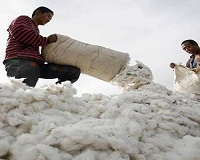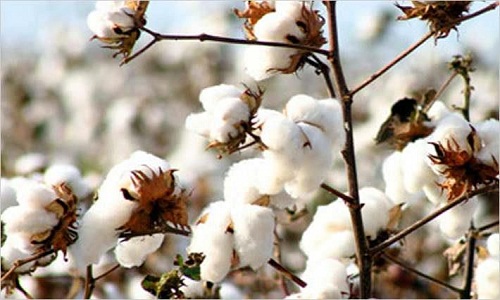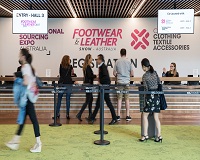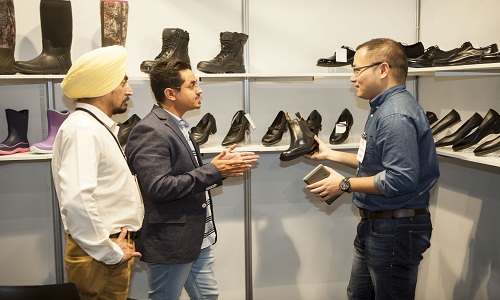FW
"Exporting three times more cotton than its closest competitor, the United States achieved a 40 per cent share of cotton fiber exports in its latest marketing year. A study conducted on mills and manufacturers from across the world aimed to understand how the US industry maintains high share of exports found the quality of US cotton to be superior then cotton from other regions. An assessment of US cotton industry and Cotton Council International’s role in the industry was conducted by a third party research firm in 2017. The firm surveyed 228 mill and manufacturers to gain insight into their purchase decisions as well as perceptions toward US cotton and the Cotton USA brand. These representatives spanned 18 countries including the six largest cotton purchasing regions in the world: Northeast Asia, Southeast Asia, South Asia, China, Latin America, and Central Europe."
 Exporting three times more cotton than its closest competitor, the United States achieved a 40 per cent share of cotton fiber exports in its latest marketing year. A study conducted on mills and manufacturers from across the world aimed to understand how the US industry maintains high share of exports found the quality of US cotton to be superior then cotton from other regions.
Exporting three times more cotton than its closest competitor, the United States achieved a 40 per cent share of cotton fiber exports in its latest marketing year. A study conducted on mills and manufacturers from across the world aimed to understand how the US industry maintains high share of exports found the quality of US cotton to be superior then cotton from other regions.
An assessment of US cotton industry and Cotton Council International’s role in the industry was conducted by a third party research firm in 2017. The firm surveyed 228 mill and manufacturers to gain insight into their purchase decisions as well as perceptions toward US cotton and the Cotton USA brand. These representatives spanned 18 countries including the six largest cotton purchasing regions in the world: Northeast Asia, Southeast Asia, South Asia, China, Latin America, and Central Europe.
Ranking the most important factors influencing cotton purchase decisions, respondents listed quality, price, overall product satisfaction, contamination and living up to their contracts as the top five factors. Respondents were then asked to rate their associations with cotton from various parts of the world.
Value for money
US cotton emerged on top because of positive factors in the decision to purchase cotton. Nearly 90 per cent respondents perceived US cotton as being of high quality, consistent, and low contamination while 75 per cent believed US cotton provides good value despite higher price points. US cotton was consistently positively rated than cotton from other parts of the world across all significant purchase factors.
respondents perceived US cotton as being of high quality, consistent, and low contamination while 75 per cent believed US cotton provides good value despite higher price points. US cotton was consistently positively rated than cotton from other parts of the world across all significant purchase factors.
With over 50 per cent respondents preferring US cotton, it was overwhelmingly the most preferred cotton by both mills and manufacturers across the world. Over one-third of the cotton purchased in the past year was reportedly from the US. This is nearly three times that of any other country. Respondents expressed great satisfaction about US cotton purchases with over 90 per cent planning to recommend US cotton to their customers.
Cotton USA’s strong brand value
As far as brand awareness is concerned, CCI, since 1989, has been licensing products such as apparel and home textile with the Cotton USA trademark. The trademark has so far, been used by over 51,000 product lines. Given this long track record, 96 per cent mills and manufacture representatives are aware of the Cotton USA brand with 77 per cent believing the trademark adds value to their business.
Reliance Industries in association with the United Nations and House of Anita Dongre has developed R Elan, a fashion line made of 100 per cent pet bottles. Discarded pet bottles are recycled into garments. This range is a blend of art and smart, with fabrics that provide several attributes such as enhanced performance, aesthetics, and sustainability. The brand is meant to serve growing consumer demands for better functionality, aesthetics and sustainability, while ensuring each level of the value chain is also benefited.
R Elan encompasses a wide range of fabrics providing superior aesthetics, functionality and sustainability. This large superior product range can serve multiple brands across multiple applications. The brand is experiencing a high level of acceptance from various brands across different applications such as active wear, denim, formal wear and women’s wear. Reliance expects this to be a pioneer in increasing acceptance of specially engineered polyesters.
World over the environmental dangers of fast fashion model of use and throw with seasonal trends are giving rise to slow fashion – where ecologically friendly clothes are designed for long term wear. Materials used are available resources which cut down the carbon footprint greatly. This not only makes fashion economically sustainable but also ecologically friendly.
Australian fashion technology firm BlockTexx will collaborate with New Zealand-based textile research company The Formary to develop new strategies and workflow models for the recycling and repurposing of textile waste.
Both firms are motivated by the fact that less than one per cent of global textile waste is currently recycled, with most of the sector’s cast-offs being shipped to developing countries where the vast majority ends up in landfill. The duo also cite the 2020 Circular Fashion System Commitment, which has seen 94 global brands – such as H&M and Adidas – commit to addressing the altering the linear approach to textile production.
Formary will extol the virtues of blockchain as a transformative industry tool at the Circular Economy Summit, which this year is being held in New Zealand and has been organised by the Sustainable Business Network’s Circular Economy Accelerator and WasteMINZ.
BlockTexx fashion technology platform will connect manufacturers, brands and logistic providers a blockchain-enabled marketplace; a method which it believes can unlock value throughout the entire supply chain.
Islamic Fashion & Design Council’s (IFDC) will host Milan Fashion Week Modest Soiree, in conjunction with Milan Fashion Week on September 24, 2018. This exclusive event will showcase Modest Fashion in the city with the greatest fashion appetite. The IFDC Award winners from Torino Fashion Week 2018 will be the main attraction of this event. These winning designers are Bow Boutique (Saudi Arabia), Al Nisa Designs (USA), Chantique (Brunei) and another made-in-Italy modest brand, Luya Moda. This event is produced by IFDC and its strategic partner, Milano Fashion Library (MFL ).
IFDC formed strategic partnership with MFL, a consulting, publishing and advertising company that operates within the largest fashion library in Europe. MFL served on the jury for the IFDC Awards at Torino Fashion Week 2018. This prestigious fashion organisation is situated in the Tortona area in Milan, which is known for hosting a number of prestigious fashion and design events throughout the year. This iconic venue is key to catapulting any designer’s career to the next level.
Some 115 tehsils have been declared as cotton growing areas in Maharashtra. Out of these, around 55 are in Vidarbha region alone. A tehsil is defined as one with cotton production of 9,600 tons per annum. This is the amount of cotton production needed to sustain a co-operative spinning mill.
The objective is to identify tehsils where co-operative spinning mills can be set up under the new textile policy. The decision of declaring 115 tehsils as cotton growing will have a long-term impact on the growth of the textile sector in a planned manner.
In the past, spinning mills were set up in parts of Maharashtra that were not cotton producing. The new policy ensures this mismatch is done away with and the foundation of a properly planned cotton-to-cloth chain development is laid.
The number of cotton growing tehsils in various districts is as follows: Jalgaon 15, Ahmednagar one, Aurangabad and Amravati nine each, Jalna, Nanded, and Akola seven each, Beed five, Parbhani and Nagpur six each, Hingoli two, Buldhana and Wardha eight each, Yavatmal 13 and Chandrapur four.
Jalgaon and Yavatmal are the districts with the highest number of cotton growing tehsils.
US multinationals are bracing up for what is shaping up to be an all-out trade war between their country and China. Within weeks, the US may impose tariffs on more than half of all Chinese exports to the US. In response China is contemplating hitting back at more than 80 per cent of US exports to China.
Tariff increases are not just a tax on consumers but also bring uncertainty to the supply chain for brands. Top brands depend a lot on a stable global supply chain. Around 1,000 types of Chinese products in the textile and apparel category are subject to tariffs imposed by the US.
But as much as US companies operating in China hate the idea of tariffs, many of them feel the threat of tariffs can be useful. The US and Chinese trade negotiators have finally begun to talk about critical issues that had been ignored for years, such as China’s industrial policies and mandatory joint venture structures that facilitate technology transfer to Chinese companies.
Multinational corporations have been growing ever more frustrated with the many hurdles they face in China, from market access restrictions to an opaque regulatory environment. Some of these issues have been repeated year after year — some of them have been issues for 30 years.
India’s cotton exports in 2018-19 are likely to be down 30 per cent. Scanty rainfall and an attack of pink bollworms are likely to squeeze crop yields. The Western states of Gujarat and Maharashtra account for more than half of the country’s total cotton production. Some regions of these two states received as much as 22 per cent less rainfall than normal.
Farmers have adopted genetically-modified seeds known as Bt cotton that are resistant to bollworms, but it hasn't stopped the infestations. Pink bollworms consume the fiber and seeds inside a cotton plant's boll, or fruit, and yields fall. Lower shipments from the world's biggest producer of the fiber amid rising demand from top consumer China could support global prices.
India is the largest cotton producer in the world, followed by China, the US, Pakistan and Brazil. The five largest exporters of cotton are the US, Australia, Brazil, India and Uzbekistan. Five major consumers of cotton are China, India, Pakistan, Bangladesh and Turkey. Buyers are interested in sourcing cotton from India as they find it cost effective and less expensive in comparison to other countries.
Apart from neighboring countries, India has been receiving demands for cotton from several other countries, including Vietnam and Indonesia.
Bread & Butter will be held in Germany from August 31 to September 2. This time the trade fair has gained an extra ampersand. The three days will be dedicated to fashion and culture. Some 40 fashion brands will vie to stand out from the crowd with runway shows, exclusive capsules, discussions, customisation workshops, DJ sets and other concerts.
The program features 43 labels – mostly fashion brands but some cosmetics manufacturers are also present – who will be trying their best to grab consumers' attention, presenting limited-edition products and capsule collections that are either exclusives or pre-launches.
Everything on display at the fair will be available for purchase on site through a cashless system created in partnership with Visa, featuring bracelets which shoppers can charge up. A number of brands have already taken to social media to try and attract visitors and potential consumers to their pop-ups.
Among the brands confirmed at the fair are: Adidas Original, Nike, The North Face, Timberland, Puma, Reebok, Columbia, Asics Tiger, Cheap Monday, Converse, Diesel, G-Star Raw, Hugo, Levi's, Obey, Pepe Jeans, Vans and Wrangler. The last edition attracted 30,000 visitors and reached 26.5 million people across Europe through social media.
Spanish apparel retailer, Inditex has supported stronger dialogue and collective bargaining between unions, garment factories and brands for living wages of garment workers. The retailer expects the collective demands of workers, expressed through their legitimate unions including Industriall Bangladesh Council, to be taken into account, and the current negotiations to reach an agreement.
Inditex is also supporting the ACT (Action, Collaboration, Transformation) – an agreement launched in 2014 between global brands and trade unions to improve garment industry wages through collective bargaining, supported by world class manufacturing standards and responsible purchasing practices. Through ACT, Inditex, IndustriAll and other global brands and retailers have earmarked Bangladesh as a priority country to promote collective bargaining as the most effective tool to reach wage agreements between employers, employees and their respective representatives. The retailer, in the next edition of its magazine has included an in-depth update on ACT, an initiative that offers the best chance f securing fairer wages in garment production hubs.
 India will have a strong participation at Footwear and Leather Show, Australia, to be held from November 20 to 22. The participation organised by the Council for Leather Exports (CLE), India’s peak export trade promotion organisation for leather industry, will see 30 footwear suppliers and leather goods/accessories and garments exhibit at the show. India is the world’s second largest producer of footwear and leather garments.
India will have a strong participation at Footwear and Leather Show, Australia, to be held from November 20 to 22. The participation organised by the Council for Leather Exports (CLE), India’s peak export trade promotion organisation for leather industry, will see 30 footwear suppliers and leather goods/accessories and garments exhibit at the show. India is the world’s second largest producer of footwear and leather garments.
Australia is a growing and significant market for leather and leather products. For the third year running, CLE is bringing its member companies to Australia to showcase the quality of their products and expand their footprint in the Australian market.
Footwear and Leather Show will feature a comprehensive range of footwear, leather and leather accessories from manufacturers and exporters looking at securing volume OEM & ODM partnerships with a trade and buying audience from across Australia, New Zealand and beyond.
Besides the intense direct business exchange on the show floor, the expo also offers a comprehensive program of learning and networking opportunities including seminars and workshops, networking events and industry presentations, providing multiple ways of engaging and establishing long-term business relationships.
learning and networking opportunities including seminars and workshops, networking events and industry presentations, providing multiple ways of engaging and establishing long-term business relationships.
India is a reliable and attractive destination for the manufacture of high end goods and CLE’s continuing participation at the Footwear and Leather Show proves this.











